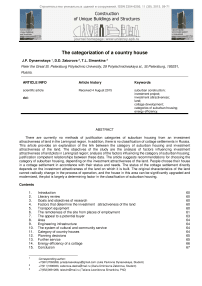The categorization of a country house
Автор: Dynaevskaya Julia Pavlovna, Zaborova Daria Dmitrievna, Simankina Tatiana Leonidovna
Журнал: Строительство уникальных зданий и сооружений @unistroy
Статья в выпуске: 11 (38), 2015 года.
Бесплатный доступ
There are currently no methods of justification categories of suburban housing from an investment attractiveness of land in the Leningrad region. In addition, there is no classification of cottage settlements in Russia. This article provides an explanation of the link between the category of suburban housing and investment attractiveness of the land. The objectives of the study are the analysis of factors influencing investment attractiveness of land plots in Leningrad region; analysis of the factors influencing the category of suburban housing; justification competent relationships between these data. The article suggests recommendations for choosing the category of suburban housing, depending on the investment attractiveness of the land. People choose their house in a cottage settlement in accordance with their status and needs. The status of the cottage settlement directly depends on the investment attractiveness of the land on which it is built. The original characteristics of the land cannot radically change in the process of operation, and the house in this area can be significantly upgraded and modernized, the plot is largely a determining factor in the classification of suburban housing.
Suburban construction, investment project, investment attractiveness, land, cottage development, categories of suburban housing, energy efficiency
Короткий адрес: https://sciup.org/14322194
IDR: 14322194
Список литературы The categorization of a country house
- Doronin S.M. Istoriya razvitiya stroitelstva zagorodnogo zhilya. M: Aviatsionnaya entsiklopediya, 2009. № 5. 254 s.
- Krasnov D.M. Lend-development -tendentsii razvitiya rynka zagorodnoy nedvizhimosti. M.: Real Press-media, 2010. 347 s.
- Sinelnikov, V.S. Entsiklopediya zagorodnogo stroitelstva. M: Eksmo, 2012. 512 s.
- Munchak L.A. Konstruktsii maloetazhnogo zhilogo doma. SPb: Arkhitektura-S, 2012. 98 s.
- Shigabutdinova L. R. Perspektivy razvitiya zemelnogo developmenta//Molodoy uchenyy. 2014. №8. S. 643-645.
- Ilin N.I., Lukmanova, I.G., Nemchin, A.M. i dr. Upravleniye proyektami. SPb: ”Dva-Tri”, 2006. S. 610.
- Izyurova, L.G. Kompleksnoye razvitiye territoriy i lend-development. M.: Real Press-media, 2011. 120 c.
- Peyzer, R.B., Frey, A.B. Professionalnyy development nedvizhimosti. Rukovodstvo ULI po vedeniyu biznesa. M: ULI-THE URBAN LAND INSTITUTE, 2005. 252 s.
- Sirazetdinov, R.M. Developlent kak innovatsionnoye napravleniye investitsionno-stroitelnoy deyatelnosti//Rossiyskoye predprinimatelstvo. 2011. №8. S. 80-84.
- Mazur, I.I., Shapiro, V.D. Development nedvizhimosti. Spravochnik dlya professionalov. M: Omega-L, 2009. 523 s.
- Mazur, I.I., Shapiro, V.D. Development. M.: Ekonomika, 2010. 528 s.
- P.Richard B. Professional Real Estate Development. ULI. 2005. S. 44-47.
- Dikman, L.G. Organizatsiya zhilishchno-grazhdanskogo stroitelstva. Spravochnik stroitelya. M.: Izd-vo Stroyizdat, 2005. 496 s.
- Dikman, L.G. Organizatsiya, planirovaniye i upravleniye stroitelnym proizvodstvom. M: Vysshaya shkola, 2007.500 s.
- SP 42.13330.2011 Gradostroitelstvo. Planirovka i zastroyka gorodskikh i selskikh poseleniy. Aktualiziro-vannaya redaktsiya SNiP 2.07.01-89*
- SNiP 30-02-97* «Planirovka i zastroyka territorii sadovodcheskikh obyedineniy grazhdan, zdaniya i sooruzhe-niya».
- Prokofyeva Ye.Yu. Sotsialno-ekologicheskiye innovatsii v planirovke zagorodnykh poseleniy.M: Izd. Moskva, 2010. 235 s.
- SNiP 30-01 «Gradostroitelstvo. Planirovka i zastroyka gorodskikh i selskikh poseleniy».
- SNiP 2.08.01-89* «Zhilyye zdaniya».
- SNiP 2.08.02-89 «Proyektirovaniye predpriyatiy bytovogo obsluzhivaniya naseleniya»
- Polyakov N. Tendentsii sovremennogo kottedzhnogo domostroyeniya//Zhurnal "ZhKKh i stroitelstvo" № 6 (№11/2006). S. 38-46.
- Nashchokina M.V. Dachnyye poselki (vtoroy poloviny XIX nachala XX vv. Selskiye poseleniya Rossii. Istoricheskiy i sotsiokulturnyy analiz. M: Eksmo, 2010. 257 s.
- Nekhuzhenko N.A. Osnovy landshaftnogo proyektirovaniya i landshaftnoy arkhitektury. Spb.: Neva, 2005. 192 s.
- Yevsyukov D.S. Razrabotka modeley obyemno-kalendarnogo planirovaniya v kottedzhnom stroitelstve. SPb: Neva, 2009. 123 s.
- Schupbach B., Zgraggen K., Szerencsits E. Inctntives for low-input land-use and their influence on the attractiveness of landscapes. Journal of environmental management. 2008. No. 89. Pp. 227-229.
- Paiho S., Abdurafikov R., Hoang H., Kuusisto J. An analysis of different business models for energy efficient renovation of residential districts in Russian cold regions. Sustainable cities and society. 2015. No. 14. 34 p.
- Darcy M. From high-rise projects to suburban estates: Public tenants and the globalised discourse of deconcentration. Cities. 2013. No. 35.Pp. 368-370.
- Richard W. Martin. Job decentralization with suburban housing discrimination: an urban equilibrium model of spatial mis-match. Journal of housing economics. 2005. No. 6. Pp. 300-302.
- Kazeykin V.S., Baronin S.A., Chernykh A.G., Androsov A.N. Problemnyye aspekty razvitiya maloetazhnogo zhilishchnogo stroitelstva v Rossii. M: Infa-M, 2011. 296 s.
- Maksakova A.N., Gorbunova V.S. Maloetazhnaya zhilaya zastroyka: plyusy i minusy.//Perspektivy nauki i obrazovaniya.2013. №6. 45 c.


